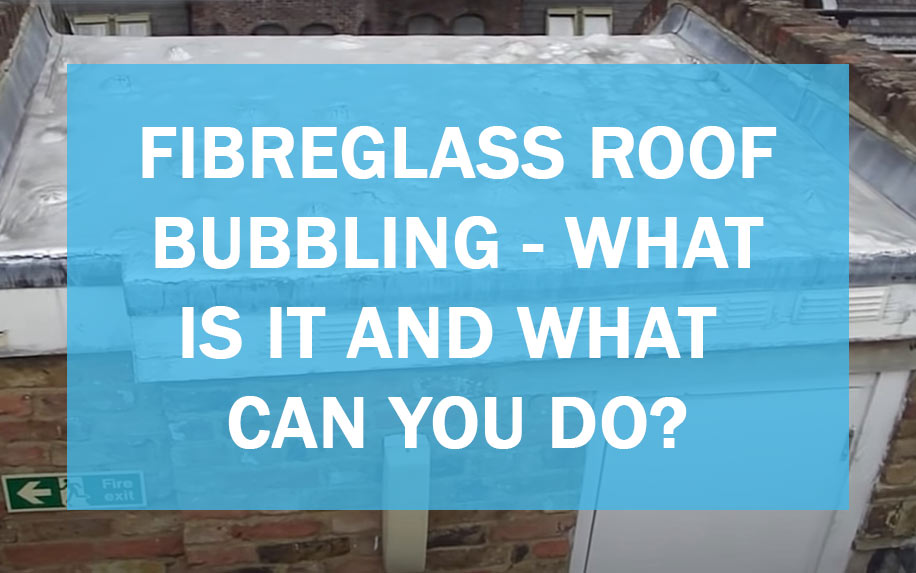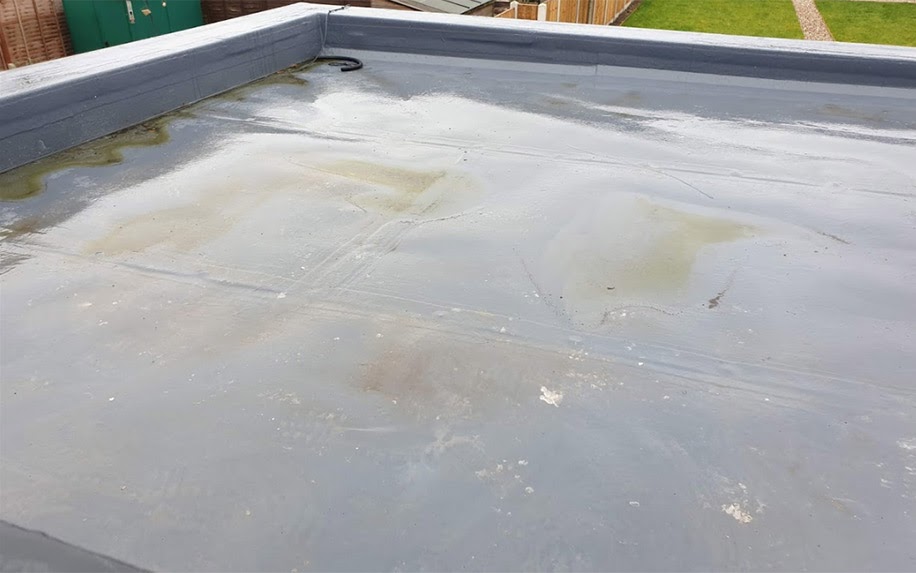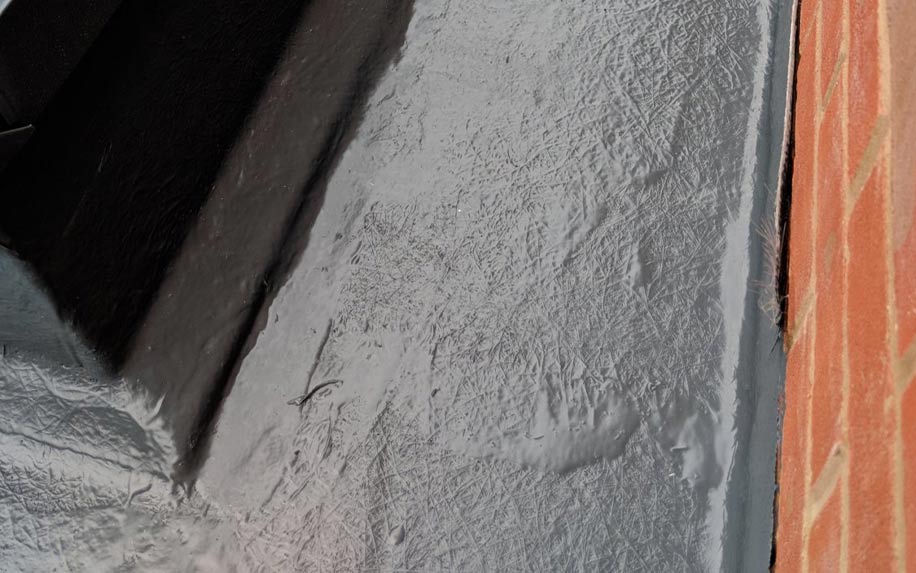

If you notice fibreglass roof bubbling, it’s normal to be concerned. After all, you’ve invested money in a fibreglass roof because of their longevity and reliability. It’s only natural that you’d be disappointed when a problem like bubbling occurs.
Generally, when a fibreglass roof is installed correctly, problems like bubbling should not occur. As such, if you notice bubbling in your roof, chances are that something has gone wrong during installation.
This highlights the fact that it’s always best to use credible, product-certified contractors on your fibreglass projects.
Let’s take a look at the causes of fibreglass roof bubbling, and what steps can be taken when it occurs.
What is Fibreglass Roof Bubbling?


Fibreglass roofs are made up of several layers, all of which play a different role. Bubbles occur when moisture or air is trapped between these layers during the installation process. Changes in temperature cause this moisture to expand, creating bubbles between the layers.
These resemble the air bubbles that you might find on a painted surface. As such, they’re pretty easy to spot with the naked eye. To find these, it’s important to check your roof regularly for visual imperfections or changes.
Depending on the extent of the problem, bubbles might appear in isolated areas, or all over the surface of your roof.
If left untreated, bubbles can contribute to a number of more serious problems. The thing is, bubbling is often a symptom of an underlying issue with your fibreglass roof. As such, it’s important to identify and treat the root cause of fibreglass bubbling.


What Causes Bubbles in a Fibreglass Roof?
So, what can actually go wrong which causes moisture to become trapped between the layers of your roof? The majority of time, this happens between laying the fibreglass matting, and applying the topcoat.
During installation, a coat of water-proof resin is applied to fibreglass matting, and the boards below, creating a laminate. The topcoat is then applied on top of this. When this process is done properly, there should be no moisture between the different layers.
If the resin is not given sufficient time to dry, or is not applied evenly, then moisture becomes trapped. If this is limited to the resin directly below the topcoat, it’s relatively simple to repair. However, bubbles can also indicate an issue with how the fibreglass mat was layed, creating a more in-depth repair job.
Fibreglass roof bubbling can also result from poor installation practices, like failure to properly clean the surface before applying the topcoat.
What Should You Do About Fibreglass Roof Bubbles?
When you encounter any kind of problem with a fibreglass roof, it’s important to seek out advice from an experienced professional. While there’s a good chance your roof will only require minor repairs, it’s still important to be certain of this before carrying them out.
A fibreglass roofing specialist will also be able to determine the root cause of your bubbling issue, and advise you on the best course of action.
Assess the Size of the Affected Area
As we said, most often bubbling occurs due to air being trapped between the topcoat and the fibreglass matting beneath, generally as a result of resin not being applied correctly. When this occurs it’s important to figure out how much of the roof’s surface is affected.
That is, you want to deduce if the problem is isolated to a small area of your roof, or if it occurs all over. This will help you to determine if minor repairs are necessary, or if an entirely new topcoat should be applied.
Minor Repairs
Assuming that the problem is moisture beneath the topcoat, and this is isolated to a small area, fibreglass roof bubbling can often be rectified with only minor repairs. Essentially, all that is needed is to replace the topcoat on the affected areas.
This requires the existing topcoat to be sanded away to reveal the resin below. This should then be thoroughly cleaned and dried, before a new layer of topcoat is carefully applied. It’s important that the new topcoat is applied to the correct thickness, to prevent cracks.
This process should be performed in dry conditions, to prevent more moisture from becoming trapped.
Replacing the Entire Topcoat
If bubbling is present across large areas of your roof’s surface, it may be necessary to replace the entire topcoat. That is, if the problem isn’t isolated to a specific area, it is likely that the entire topcoat has been applied poorly in the first place.
The process for doing this is essentially the same. The topcoat should be stripped off to expose the underlying resin. When this is fully clean and dry, a new layer of topcoat can be applied to the entire roof.
At this point, it’s worth remembering that your initial problem resulted from poor installation.
As such, it is not recommended that you attempt to reapply the topcoat yourself. In short, there is a good chance that the problem will reappear, defeating the entire purpose of recoating your fibreglass roof.
Instead, major repairs to your roof should only be carried out by reputable fibreglass specialists.
Bubbles Indicating More Serious Problems
As noted, fibreglass roof bubbling can also indicate more serious problems. The most common is that the resin beneath the fibreglass matting has also been applied poorly.
Bubbles can be a symptom of what’s known as resin starvation. Essentially, this is where the fibreglass matting has not been sufficiently coated in resin. The dry areas then allow moisture to penetrate the roofing system.
In the most extreme cases, the entire fibreglass roof system may need to be replaced to rectify this issue.
At this point, we should re-emphasise the importance of seeking advice from qualified professionals when you notice bubbling in your fibreglass roof. If you simply try and perform a DIY repair without understanding the ultimate cause of your bubbling issue, you may simply prolong or cover up an underlying issue with how your roof was installed.
How to Prevent Fibreglass Roof Bubbling
Ultimately, the best way to prevent fibreglass roof bubbling is to make sure your roof is installed correctly in the first place. The only way to do this is by working with an experienced, product-certified installer.
Additionally, choosing the right fibreglass roof products for your specific weather conditions can help to prevent bubbling. For example, preformed systems like Dryseal are ideal for installation in Ireland, given the frequent wet weather.
Bubbling between the resin and topcoat can also be prevented by using high quality products, which are designed to work together, such as CureIt fibreglass roofing products.
Nationwide Fibreglass are the top GRP roofing specialists, offering services to domestic and commercial customers all over the island of Ireland. If you need advice regarding your fibreglass roofing needs, don’t hesitate to get in touch and speak to one of our experts.
